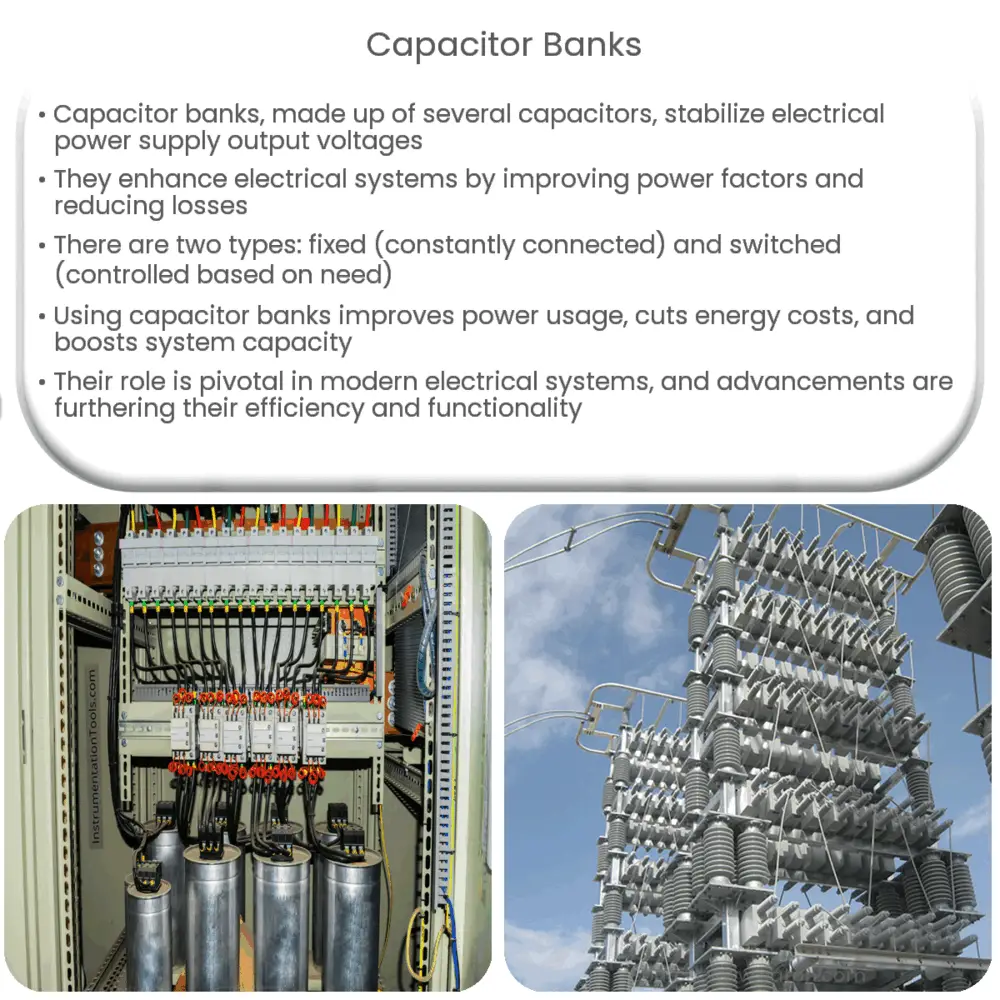Explore the importance, types, benefits, and applications of capacitor banks in electrical systems, as well as future trends.

Introduction to Capacitor Banks
A capacitor bank is a grouping of several capacitors interconnected in parallel or series, or a combination of both. Capacitor banks are primarily used in power conditioning applications, providing additional capacitance to an electrical power supply and thus stabilizing its output voltage.
Capacitor banks are critical to electrical systems and networks because of their ability to improve the power factor. By so doing, they effectively reduce power system losses and enhance the overall system capacity.
How Capacitor Banks Work
Capacitor banks operate on a relatively simple principle. When electrical power is supplied to the bank, capacitors in the bank store this energy and release it when the power supply’s output begins to drop. The mechanism is akin to a reservoir storing water and releasing it when needed. This process ensures a stable, consistent power supply, crucial in numerous applications, from industry to consumer electronics.
Types of Capacitor Banks
- Fixed Capacitor Bank: This type of bank remains connected to the system all the time, providing a constant level of capacitance.
- Switched Capacitor Bank: These can be connected or disconnected based on the system’s needs. They are often controlled using automated systems that respond to the power system’s reactive power demand.
Benefits of Capacitor Banks
The use of capacitor banks comes with several advantages, some of which are as follows:
- Improved Power Factor: By correcting the power factor, capacitor banks can increase the effective usage of electrical power.
- Reduced Energy Costs: Through improved power factor, they can reduce the apparent power in the system, resulting in lower energy costs.
- Increased System Capacity: By decreasing the total current flowing through the network, capacitor banks can increase the overall system capacity.
Applications of Capacitor Banks
Capacitor banks are employed in a wide range of applications. Some notable areas of use include:
- Power Distribution Networks: They help maintain voltage quality and stability.
- Industrial Applications: Industries with inductive loads like motors and transformers greatly benefit from capacitor banks as they improve system efficiency.
These uses of capacitor banks underscore their importance in maintaining and enhancing the performance of electrical systems.
Design and Implementation of Capacitor Banks
Designing a capacitor bank requires careful consideration of several factors including the required reactive power, voltage, and current conditions. These considerations help determine the size and number of capacitors needed. For implementation, capacitors are typically connected in parallel, which allows for individual capacitors to be switched in or out of service based on system needs.
Regulation and Safety Aspects
Like other electrical equipment, capacitor banks are subject to specific standards and regulations. These include the likes of IEEE and IEC standards, which dictate safety and operational requirements. Regular inspections and maintenance are recommended to ensure longevity and safety. This includes monitoring for signs of wear or damage, such as bulging or leaking capacitors, and checking for the presence of harmonic distortion.
Potential Issues and Mitigation
Despite their benefits, capacitor banks are not without their challenges. One issue is the potential for harmonic resonance, which can cause system overvoltage and equipment damage. However, this can be mitigated through the use of harmonic filters or de-tuned capacitor banks.
Emerging Trends
As we move towards a more digitally controlled and renewable energy focused future, the role of capacitor banks is expected to become even more crucial. Developments in power electronics and intelligent control systems are driving the evolution of capacitor bank technology. Advanced capacitor banks now offer features such as real-time monitoring and automated switching, which further enhance system efficiency and reliability.
Conclusion
In conclusion, capacitor banks play a pivotal role in modern electrical systems, improving power quality, reducing energy costs, and increasing system capacity. Their importance in maintaining and enhancing the performance of electrical systems cannot be overstated. With ongoing advancements in technology, it is anticipated that the functionality and efficiency of these banks will only continue to improve. While there are challenges to consider, such as the potential for harmonic resonance, these can be effectively mitigated with careful design and use of complementary technologies. As such, capacitor banks will continue to be an indispensable tool in the power engineering landscape.

